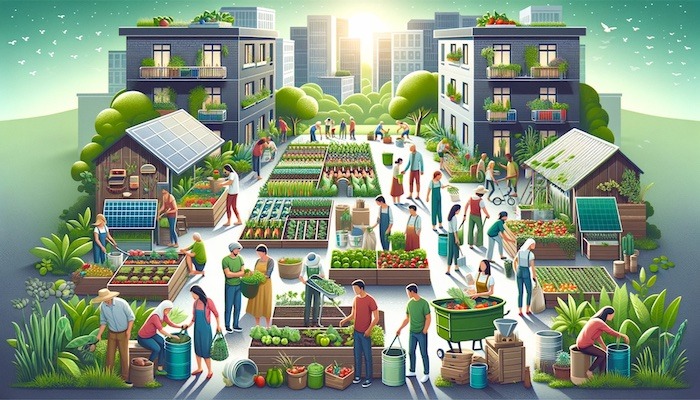
Community Engagement in Sustainable Healthy Living
Bruce Gibson ND
3 min read


Community engagement is a vital aspect of sustainable healthy living. It involves actively participating in community activities, supporting local initiatives, and contributing to the development of a sustainable society. Engaging with your community not only fosters a sense of belonging and purpose but also amplifies the impact of individual actions towards sustainability.
Supporting Local Businesses
One way to engage with your community is by supporting local businesses. This can involve shopping at local farmers' markets, frequenting local stores, or using services provided by local businesses. Supporting local businesses helps to strengthen the local economy, often provides more sustainable products and services, and reduces the carbon footprint associated with transporting goods from far away (1).
Participating in Community Initiatives
Participating in community initiatives is another form of community engagement. This can include joining local clean-up efforts, participating in tree-planting events, or getting involved in community gardening projects. These activities not only contribute to a more sustainable community but also provide opportunities to connect with like-minded individuals and foster a sense of community spirit.
Advocating for Sustainable Policies
Community engagement also involves advocating for sustainable policies at the local level. This can involve attending community meetings, voicing support for sustainable initiatives, or even running for local office. Advocacy can influence local policies and regulations to support sustainability, such as promoting renewable energy, improving public transportation, or implementing recycling programs.
Educating and Raising Awareness
Educating others and raising awareness about sustainability issues is another important aspect of community engagement. This can involve organizing or participating in educational events, sharing information about sustainability on social media, or simply discussing these issues with friends and family. Education and awareness are crucial for driving behaviour change and promoting sustainability within the community.
Volunteering
Volunteering is a direct way to contribute to your community. Many organizations and initiatives could benefit from volunteer support. Whether it's helping at a local food bank, assisting in a community garden, or volunteering for a local environmental organization, these activities can make a significant difference in promoting sustainability at the community level.
In conclusion, community engagement is a powerful tool for promoting sustainable healthy living. It allows individuals to contribute to sustainability in their communities, fosters a sense of belonging and purpose, and amplifies the impact of individual actions. By engaging with our communities, we can collectively work towards a more sustainable and healthy future.
Building Resilient Communities
Community engagement is also about building resilience. Resilient communities are better equipped to handle challenges, whether they're environmental, economic, or social. By working together, communities can develop strategies to deal with issues such as climate change, natural disasters, or economic downturns. This might involve creating community emergency plans, developing local food systems to ensure food security, or setting up support networks for vulnerable community members.
Creating Inclusive Spaces
Community engagement in sustainable living also means creating inclusive spaces. This involves ensuring that all community members, regardless of their age, race, gender, or socioeconomic status, have access to green spaces, healthy food, and opportunities to participate in community activities. Inclusive communities are more likely to be successful in their sustainability efforts because they harness the diverse skills, perspectives, and experiences of all their members.
Promoting Sustainable Urban Planning
Community engagement can also influence sustainable urban planning. Residents can advocate for the development of green spaces, pedestrian-friendly streets, bike lanes, and public transportation options. These features not only improve the quality of life in the community but also promote sustainable practices like active transportation and recreation in nature.
Sharing Resources and Skills
Community engagement often involves sharing resources and skills. This can take the form of tool-lending libraries, skill-sharing workshops, or community gardens. Sharing resources and skills not only promotes sustainability by reducing consumption and waste but also strengthens community bonds and fosters a sense of mutual support and cooperation.
Fostering a Culture of Sustainability
Finally, community engagement fosters a culture of sustainability. When sustainability becomes a shared value in a community, it's easier to implement sustainable practices and policies. Community events, festivals, and traditions can be opportunities to celebrate and reinforce this culture of sustainability.
In conclusion, community engagement is a multifaceted and powerful aspect of sustainable healthy living. It's about more than just individual actions; it's about coming together as a community to create a sustainable and healthy environment for all. By engaging with our communities in these ways, we can make a significant impact on both our personal health and the health of our planet.
References:
Martinez, S., Hand, M., Da Pra, M., Pollack, S., Ralston, K., Smith, T., ... & Newman, C. (2010). Local food systems: Concepts, impacts, and issues. US Department of Agriculture, Economic Research Service.
Norris, F. H., Stevens, S. P., Pfefferbaum, B., Wyche, K. F., & Pfefferbaum, R. L. (2008). Community resilience as a metaphor, theory, set of capacities, and strategy for disaster readiness. American journal of community psychology, 41(1-2), 127-150.
Talen, E. (1999). Sense of community and neighbourhood form: An assessment of the social doctrine of new urbanism. Urban studies, 36(8), 1361-1379.
Seyfang, G., & Smith, A. (2007). Grassroots innovations for sustainable development: Towards a new research and policy agenda. Environmental politics, 16(4), 584-603.
Maniates, M. F. (2002). Individualization: Plant a tree, buy a bike, save the world?. Global environmental politics, 2(3), 31-52.
Let's talk about it...
Community Engagement in Sustainable Healthy Living

